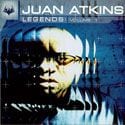
For once, the word “legend” actually applies: Juan Atkins is widely acknowledged, along with his old partners Derrick May, Kevin Saunderson and Rick Davis, as one of the founding fathers of Detroit techno, and even released a track way back in 1982, Cybotron’s “Clear”, that’s considered to be the first real techno record. So a new release from Juan Atkins is a pretty big deal, even when it’s a DJ mix like Legends: Volume 1 instead of an album of original songs.
Atkins faces the same challenge as a lot of living legends: trying to remain relevant in the here and now when so much of his reputation is based on past glories. Wisely, Atkins confronts that issue here by avoiding classic techno tracks in favor of more recent techno and house releases, with a heavy emphasis on the latter — in fact, Legends is arguably more of a house record, with far more emphasis on vocals, funky basslines, and acoustic instrumentation than the minimalist beats and synths of conventional techno.
Atkins has been moving towards a warmer sound for some time, as he demonstrates on his opening track, his own “I Wanna Be There” from the 1995 album Deep Space, released under one of Atkins’ many pseudonyms, Model 500. “I Wanna Be There” is the logical fulfillment of early techno’s Kraftwerk-influenced sound, a frictionless joyride through a sleek landscape of jazzy synths and drum machines. It’s techno, yes, but the antithesis of the bangin’ east coast version typically associated with the term nowadays, as championed by DJs like Armand Van Helden and Frankie Bones. It may or may not get you dancing, but its ever-evolving swirls of melodic, percussive keyboards are guaranteed to grab your attention and hold it.
The first part of Legends progresses in a similar vein, with low-key tracks like Individual Orchestra’s “1, 2, 7, 29, 10, 14” (how’s that for a classic techno title?), a lovely, almost ambient number that Atkins brings some real tension to by cleverly raising and dropping his levels and mixing out most of the bass. Atkins, really a producer more than a DJ, lacks some of a good mixer’s conventional skills — his transitions, for example, are often jarringly abrupt — but his ear for each track’s inner dynamics is outstanding, and you can really hear him throughout Legends teasing maximum dancefloor energy out of every tune.
With Isolee’s “Beau Mot Plage”, Atkins injects a Latin house vibe into the proceedings, then brings it back into darker tech house territory with DJ Sneak’s pounding but fairly unremarkable “Dancin’ Therapy”. For most of the rest of Legends, Atkins freely mixes styles but anchors everything with a straight house backbeat. The techno elements creep in from time to time, adding some nice edginess to funky tracks like Kead’s “Whatchugonnado”, with its oscillating synth riffs and thundering backbeat, and the Controller’s “Bitch on Ice”, which has the jagged sound of a hard house track being played over an old AM car radio. But for the most part, Atkins picks tracks that are warmer and groovier than conventional techno, and ultimately make for a CD that’s more fun to dance to, but may disappoint purists.
Still, I can’t imagine even Detroit techno purists resisting a one-two funky house punch like En-core’s “Coochy Coo” and Hatiras’ “Spaced Invader”, or the galloping snare drums and filtered disco guitars of Aphrohead’s (a.k.a. Felix da Housecat) “Days of the Phuture 96”. It’s pretty clear that techno legend Atkins is not setting out to break new ground here, but just having fun with some of the bouncier offshoots of the music he helped to create. Does he live up to past glories? Who cares? Even legends can’t, and shouldn’t, churn out groundbreaking classics every time. Legends is a solid, above-average dance mix, and proves that Atkins can spin other people’s records as well as he can create his own.
